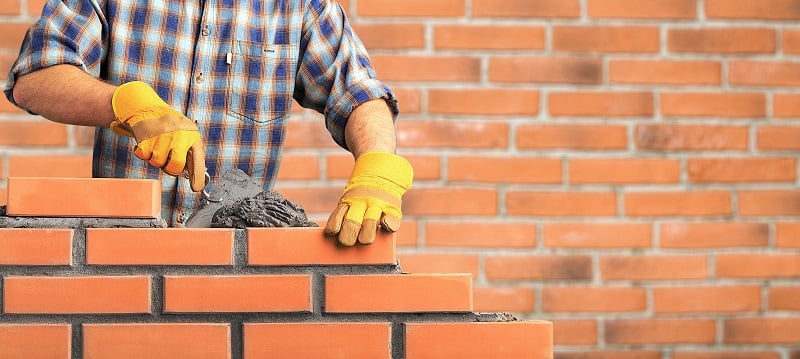Dependable Tuckpointing Services for Fixing Brick and Stone Surfaces
Dependable Tuckpointing Services for Fixing Brick and Stone Surfaces
Blog Article
Opening the Keys of Lasting Stonework Building And Construction Practices for Eco-Friendly Structures
Among the myriad approaches to environment-friendly structure, sustainable stonework building and construction stands out as a time-tested and resilient approach that holds a wealth of untapped capacity. From the selection of products to innovative building strategies, the secrets to accomplishing sustainability within stonework construction are diverse and fascinating.
Benefits of Sustainable Masonry Construction
Welcoming lasting stonework building practices not only reduces environmental impact yet additionally uses long-lasting economic benefits to contractors and neighborhoods. By making use of products like recycled blocks, obstructs, and rocks, home builders can considerably reduce the carbon impact of their tasks while advertising source effectiveness. In addition, lasting stonework building and construction techniques, such as proper insulation and thermal mass properties, can enhance energy efficiency within structures, bring about lowered functional expenses over time.
Moreover, the sturdiness and resilience of stonework structures add to long-term financial advantages. Buildings constructed using lasting stonework practices often call for less repair and maintenance, equating to set you back savings for builders and homeowner. The durability of stonework products also makes sure that frameworks remain secure and protected, reducing the demand for frequent improvements or substitutes.
Eco-Friendly Masonry Products
Using environmentally friendly masonry products is a critical action in the direction of improving the sustainability of construction techniques and lessening environmental effect while taking full advantage of long-term financial benefits. Lasting masonry materials are sourced, created, and made use of in a way that lowers total environmental effect. Products such as recycled bricks, recovered rock, and lasting concrete blocks are coming to be progressively prominent options for eco-conscious builders. Recycled bricks, for example, not only draw away waste from land fills yet additionally require much less power to create contrasted to brand-new bricks. Recovered stone provides a special aesthetic charm while decreasing the requirement for new quarrying. Sustainable concrete blocks incorporate recycled aggregates and may include improved insulation properties, adding to power performance in structures.
Furthermore, all-natural products like adobe, rammed earth, and straw bales provide excellent thermal mass buildings, lowering the requirement for home heating and cooling power. These products are typically locally offered, promoting local economic climates and minimizing transportation-related carbon emissions. By picking green stonework materials, building and construction projects can significantly lower their ecological footprint and add to the development of healthier, more lasting developed environments.
Energy-Efficient Masonry Strategies
Energy effectiveness plays a critical duty in enhancing the sustainability of masonry building practices. One key energy-efficient masonry technique is the use of thermal mass, which involves including thick products like concrete or block right into the structure's framework to soak up and save warmth.

Developments in Sustainable Stonework
Current improvements in sustainable stonework practices have actually produced ingenious techniques that are improving the building industry. One such innovation is the growth of self-healing concrete, which utilizes bacteria installed within the concrete to heal splits autonomously. This innovation not just reduces upkeep prices however additionally improves the toughness of masonry frameworks, adding to their sustainability.
Another remarkable development is the usage of recycled aggregates in stonework building and construction - masonry contractor. By integrating products such as smashed ceramic waste or recycled glass into concrete blends, contractors can lower the environmental influence of construction tasks while preserving architectural stability. This technique not only draws concrete sidewalk designs away waste from land fills but likewise preserves natural deposits, making it a crucial innovation in sustainable masonry construction
Moreover, the combination of electronic layout devices, such as Structure Information Modeling (BIM), is transforming the means masonry structures are prepared and built. BIM permits even more precise computations, lowered product wastefulness, and improved energy effectiveness, eventually leading to more lasting structure techniques. These developments collectively indicate an appealing future for sustainable masonry building in the era of environmentally friendly buildings.
Future Trends in Masonry Sustainability
With the cutting-edge strides made in lasting masonry practices, the future trends in stonework sustainability are poised to further read here revolutionize the building and construction market. One of the vital patterns shaping the future of stonework sustainability is the raised combination of technology. Advancements such as Structure Info Modeling (BIM) and virtual fact simulations are being used to optimize stonework construction procedures, bring about minimized material waste and improved power effectiveness in structures.
Moreover, the development of unique lasting materials is set to play a substantial function in enhancing the eco-friendliness of stonework building and construction. masonry contractor. Technologies like self-healing concrete, recycled accumulations, and bio-based binders are obtaining grip for their ability to decrease ecological effect while preserving architectural integrity

Verdict
Finally, lasting stonework construction methods supply various advantages for environmentally friendly structures. By using green materials and energy-efficient methods, stonework can add to a more lasting constructed setting. Developments in sustainable stonework are continuously being established to better enhance the environmental efficiency of structures. Looking towards the future, the trend of stonework sustainability is anticipated to grow, causing even more eco pleasant and energy-efficient construction methods in the years ahead.
Report this page